Chip Ganassi: an American winner
Never far from a victory, the famous team owner tells us why he has no intention to turn his back on the track
James J Black / Indycar
Chip Ganassi has a one-word answer when asked what keeps him coming back to motor racing year after year…
“Winning.”
Now entering his 37th season as a team owner, Ganassi’s multifaceted organisation has a new look for 2025. The five-car attack on the IndyCar Series has been downsized to three, still anchored by multiple champions Scott Dixon and Álex Palou. There’s a new technical alliance in IndyCar that will supply car set-ups, dampers and engineering support to Meyer Shank Racing, and for the first time in nearly 20 years Chip Ganassi Racing will field two cars in the junior Indy NXT championship.
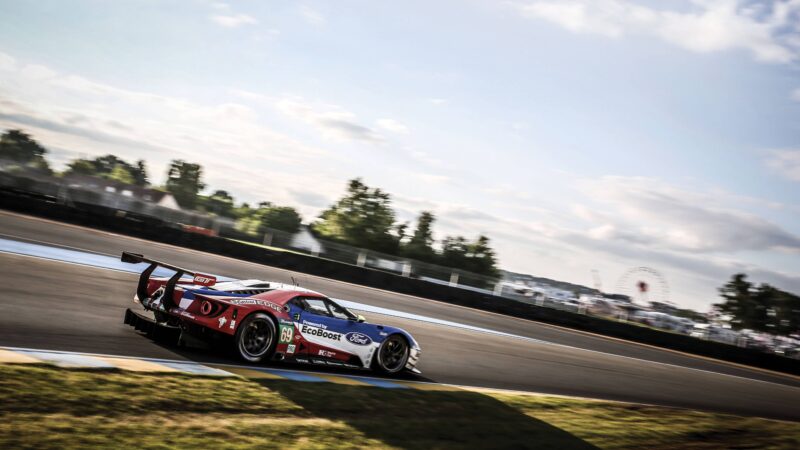
Scott Dixon made his Le Mans debut in 2016, co-driving a Chip Ganassi Ford GT; he finished third in class
Getty Images
Gone from the slate this year is Ganassi’s presence with Cadillac in the IMSA SportsCar Championship and the FIA World Endurance Championship, but that can be viewed more as a sabbatical, as the team regroups and prepares to forge a new manufacturer partnership. Savvy prognosticators are already linking CGR to Ford’s recently announced Hypercar/LMDh programme.
Like many in the industry, Ganassi is bullish on the state of worldwide sports car racing. He’s tasted plenty of success in that realm since 2004, notching five IMSA championships, six overall wins at the Daytona 24 Hours and a Le Mans class victory in factory partnerships with Lexus, BMW, Ford and Cadillac. You can almost feel his anticipation to get back in the ring, whether it’s at Sebring or La Sarthe.
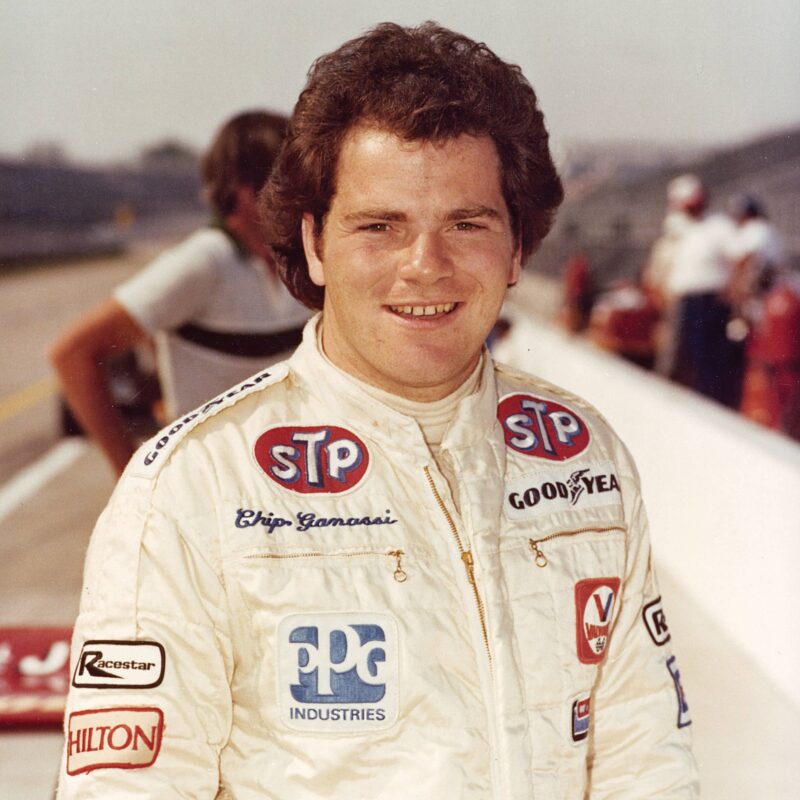
Chip was a regular racer until a crash in ’84
“There’s no better umbrella statement than to say it’s the golden era of sports car racing,” Ganassi says. “How many years have there been questions about manufacturers and racing? Whether it was the Dodge Neon series or the Mazda MX-5 Cup or the Ferrari Challenge… God forbid, it looked like manufacturer involvement in racing was going to be nothing but single-make series for a while. You couldn’t scare up a company to be involved in big-time professional racing. Now the pendulum has gone the other way. In everything from Formula 1 to sports car to IndyCar to NASCAR, you’ve got factories involved in multiple series and multiple formula at the same time. That’s huge. It might not just be the golden era of sport car racing, but the golden era of auto racing.
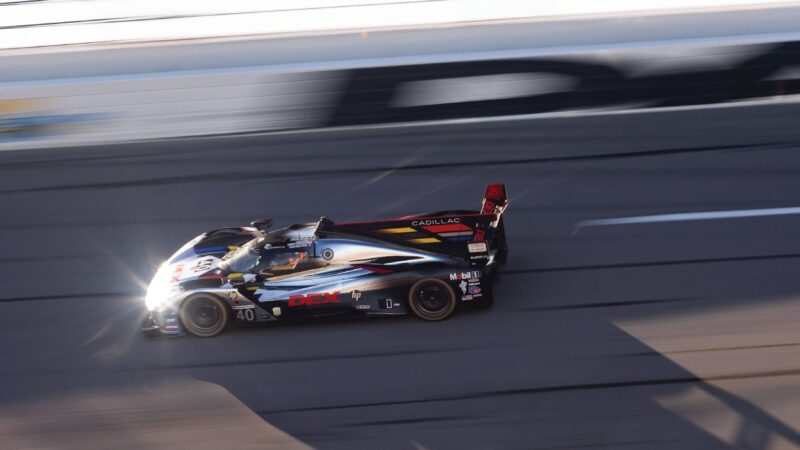
Ganassi is currently out of sports car racing after its Cadillac split.
“We were obviously doing the Cadillac programme, and everybody decided that maybe going in another direction was the best thing,” he adds. “And when you’re doing those factory programmes, you kind of have to take a year off in between them. We’re in that ‘year off’ mode right now, and I feel confident we’ll be back there next year. Some years, you’ve got to roll with the way the tide is going. You can only surf when there’s a wave.”
Still, IndyCar racing remains Ganassi’s bread and butter. It’s easy to forget that he was once a promising open-wheel driver; the Pittsburgh native started out in Formula Fords in 1977 and placed in the top five at the 1979 and ’80 SCCA National Runoffs. He then graduated to Formula Super Vee, competing against the likes of future IndyCar greats Al Unser Jr and Arie Luyendyk.
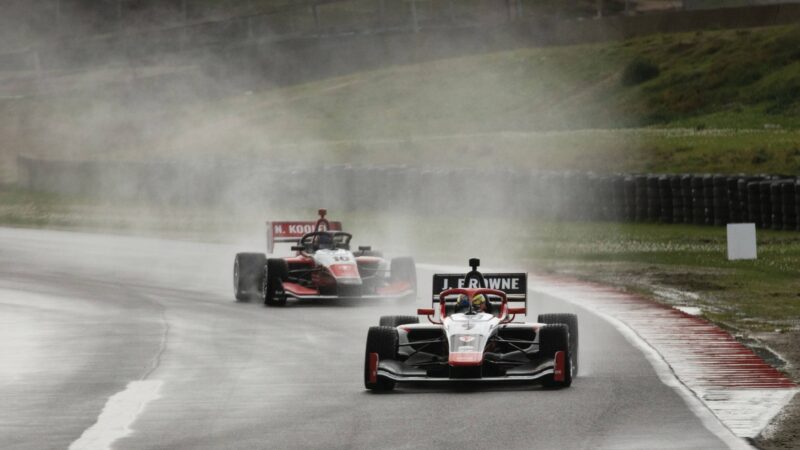
Irishman Jonathan Browne is driving for Ganassi in this year’s Indy NXT
Travis Hinkle/ims photo
At age 24, Ganassi was the fastest rookie qualifier for the 1982 Indianapolis 500, outclassing Danny Sullivan and Bobby Rahal. He moved to Patrick Racing in 1983 and finished eighth at Indy before wrapping up the year with top six finishes in the year’s final four races, including podiums at Las Vegas and Laguna Seca where he shared the rostrum with Teo Fabi and Mario Andretti.
Ganassi’s best IndyCar result came at Cleveland in 1984 when he finished second to Sullivan, but a huge accident in the next race at Michigan International Speedway ended his season with severe closed head injuries. He contested the Indy 500 and one other race in 1985 and ’86 before electing to concentrate on racing’s business side.
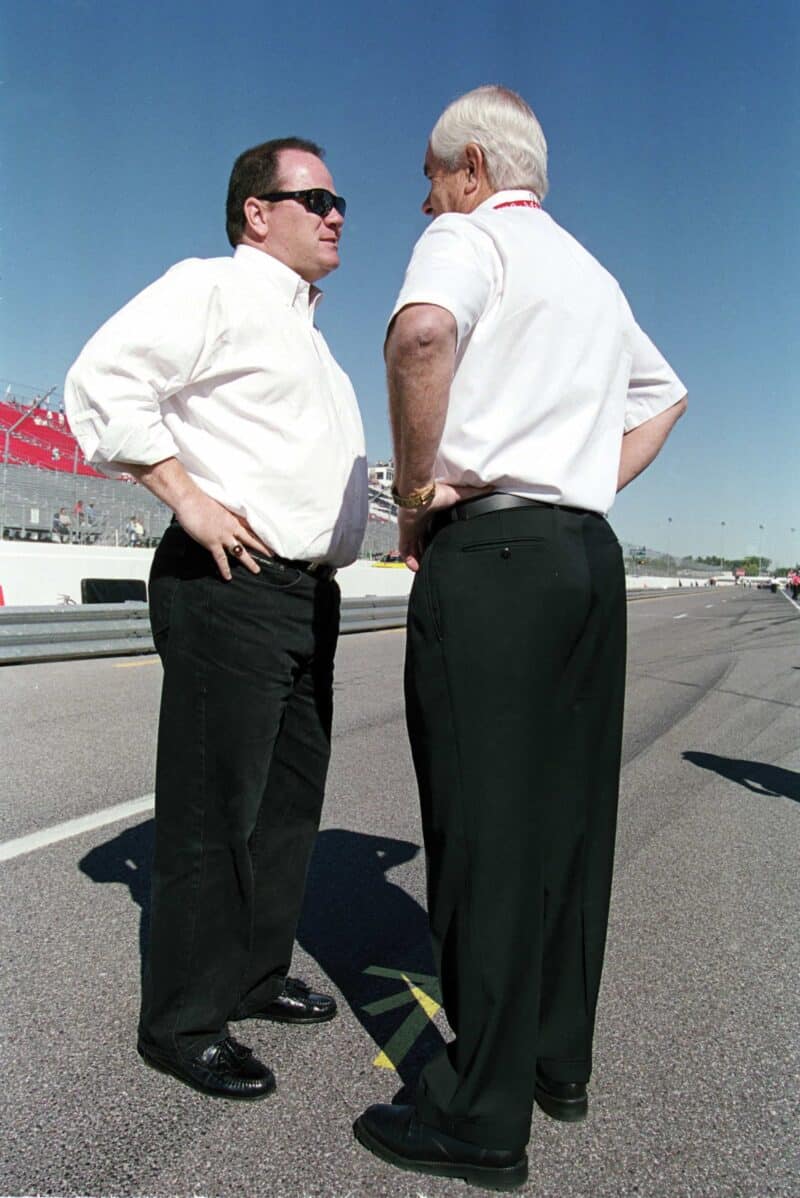
Ganassi and Roger Penske, 2000
A graduate of Duquesne University in Pittsburgh, Ganassi purchased a share of Patrick Racing in 1988 before taking the reins solo in 1990, establishing a commercial partnership with the Target department store chain that would last a remarkable 27 years. Michael Andretti earned the first IndyCar win for Chip Ganassi Racing (and Reynard) in the 1994 CART season opener at Surfers Paradise, Australia, and the Ganassi organisation has since established itself as Team Penske’s most credible and enduring rival. CGR has racked up 138 race wins and 16 CART or IndyCar championships; Penske’s corresponding numbers in that same time period are 184 wins and eight titles. However, Roger Penske has claimed 13 of his record 19 Indianapolis 500 wins since 1990, while Ganassi remains stuck on five, the last coming in the hands of Marcus Ericsson in 2022.
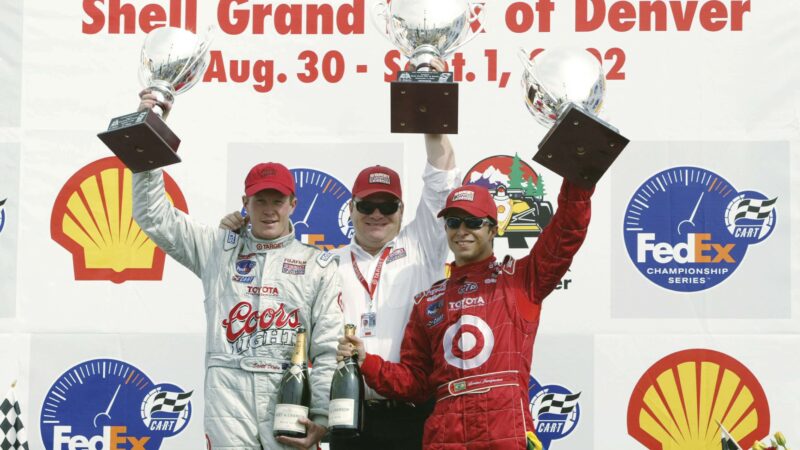
From left: Scott Dixon, Chip and Bruno Junqueira after a Ganassi Champ Car 1-2 at Denver in 2002
Getty Images
“Roger is the guy who set the bar, and he’s the guy that I wanted to model my team after,” Ganassi says. “It’s been a great rivalry for however long. He’s a great friend of mine, a great competitor, and a great mentor to many people in this sport, not just myself. The longer I’m in this, the more I realise that we have IndyCar racing today because of the leadership he demonstrated long before he owned the series. Everything from work practices to scheduling to pieces on the car are directly related to Roger’s stewardship of the sport over the years.
“Having a competitor like that, having somebody that wants to push things and drive his team to a higher standard, I think that’s what keeps us sharp,” he adds. “Roger may not be on the pitbox for his IndyCar team any more, but he’s still running it. And it’s even sweeter to beat him now.”
Throughout his time as a team owner, Ganassi gained a reputation for talent-spotting, as a series of drivers including Alex Zanardi, Juan Pablo Montoya and Scott Dixon blossomed into dominant champions while driving for his team. Dario Franchitti was already an established star when he joined CGR, but he enjoyed the most successful period of his IndyCar career while in Ganassi’s employ, taking three of his four championships and two of his three Indy 500 wins between 2009 and ’12. Franchitti’s driving career ended at the end of 2013, but he remains on the Ganassi payroll as a driver coach and engineering liaison – and is a key element to the team’s track success.
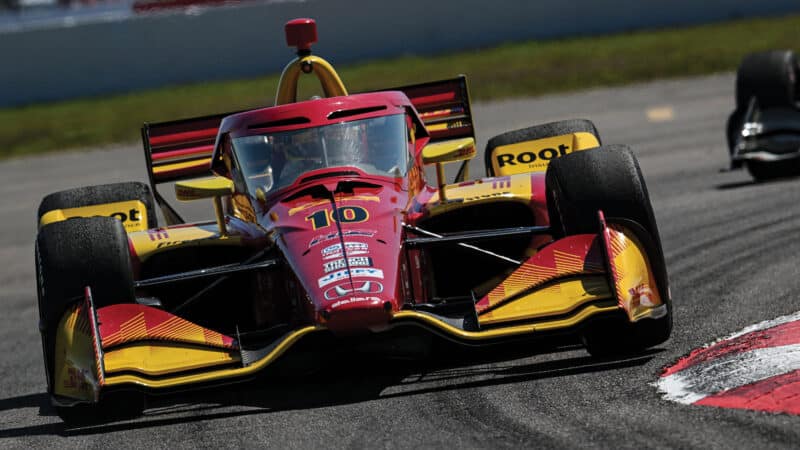
In the first IndyCar race of 2025, at the St Petersburg GP, Ganassi’s Álex Palou stormed to victory after starting in eighth
Dixon joined the Ganassi effort in mid-2002 and since then he’s collected six IndyCar championships and ranks second only to AJ Foyt on the all-time list of race winners. The New Zealander has been partnered by no fewer than 26 team-mates during his long tenure with CGR.
“Roger Penske is the guy that I wanted to model my team after”
“Dixon, I’ve never seen a guy like him where for 25 years, you just can’t count him out. It’s astounding,” Ganassi marvels. “He’s the kind of guy any team would want to have as its lead driver, because he knows how to win races, and he knows how to win championships. You can’t say that for everyone. The best thing about him is that nobody is a better person than Scott Dixon, whether that’s as a racing driver, a friend, a husband, a father, you name it.”
Álex Palou is Ganassi’s latest ‘discovery’; after a promising rookie season with Dale Coyne Racing in 2020, Palou has cruised to three IndyCar championships with Ganassi in the past four years, all while dealing in the background with the on-going legal aftermath of an aborted switch to the McLaren IndyCar team. Palou is still two years from turning 30.

Earnhardt Ganassi Racing’s Jamie McMurray won the 2010 Daytona 500 but NASCAR didn’t give Chip the success he’d grown to expect from other racing series
“To the outside world, some of our decisions look like they were made by a dartboard throw,” Ganassi admits. “But we’ve always tried to leave emotion out of decision-making. Believe me, I’m pleasantly surprised. Three championships in four years, that’s rarefied air. And if you look at the last few years, there was this sideshow going on. I never saw a guy that could keep the sideshow like that out of his head on Sunday, or even on Friday and Saturday. To me, that’s a strong-willed person, very strong of mind and body.
“The other thing is he likes Indy [the Indianapolis Motor Speedway]. There are a lot of guys that come over here and get in these cars and they do really well, but they don’t seem to like Indy. I don’t know if it’s an old-school thought, but for me anyway, that’s a problem.
“Álex is as serious as they get as a race driver, but I think a side of him that a lot of people don’t see is his humour,” Chip adds. “He has a sharp wit and that’s important in the world today. There’s a lot of things going on in this world on a day-to-day basis. You’ve got a blend of Dario and Dixon there, and because those guys are around, I’m sure he’s picked up a thing or two from them.”
There have been reports of team owner unrest within the IndyCar ranks, as even under direct Penske management the series continues to lag far behind NASCAR in terms of its popularity and prestige in the US. And that doesn’t factor in the recent growth of Formula 1 in America, which some believe has come at a cost to IndyCar support. But Ganassi doesn’t see a doom-and-gloom scenario and preaches patience, especially given the recent news that fan-friendly Indianapolis Motor Speedway president Doug Boles has now assumed the same lofty role for the entire IndyCar Series.
“I wouldn’t go so far as to say they are stagnant and falling behind, but it’s no secret IndyCar doesn’t enjoy the factory participation that sports car racing does,” Ganassi observes. “I think IndyCar is well on its way to some good things. Doug is obviously a seasoned executive and he understands the players and the political arena. Those all play to his strengths.
“It’s the same old things – if we could get another manufacturer in, that would be great. There’s a new car coming on [in 2027 or ’28]. Things are already in motion, with the new Fox TV package, and just being a good partner in some of the things that are already happening. Give it a tune-up here and there, get involved in some things, and then stay out of the way in some other areas and everything is going to be just fine.”
Ganassi doesn’t view Formula 1’s explosion in popularity in the US over the past five years – often attributed to the Drive to Survive phenomenon – as a problem for IndyCar.
“I like to be involved other than just coming up with the money”
“I’ve always felt that a rising tide lifts all boats,” he says. “I think we’re seeing some of that in IndyCar right now, with respect to Formula 1. I think there are plenty of companies that realise we’re a better value package in terms of what you can get for what you pay. The television programming is the fulcrum in the see-saw of motor sports, and I think you’re already seeing results from that Fox affiliation. Let’s face it, six times more people saw that Álex Palou ad during the Super Bowl than the number of people who saw IndyCar on TV at all during the last year. So that’s a pretty big number. I don’t know that they are pinning their hopes on that, but it’s a huge part of an ongoing plan to make things better around IndyCar racing.”
For more than 20 years Ganassi was involved in NASCAR, as a sole team owner or in partnership with Felix Sabates or Dale Earnhardt Inc. But Ganassi’s NASCAR team never achieved the level of success he was accustomed to in Indycars and sports cars, winning a total of 15 Cup Series races including the 2010 Daytona 500.
Three full seasons have passed since Chip sold his NASCAR operation and franchise charter to Justin Marks, who rebranded it to Trackhouse Racing. The incessant grind of the NASCAR schedule, with 39 weekends of competition across 10 months, caused Ganassi to re-examine his work-life balance.
“It was the right time for me,” Ganassi says of his withdrawal from the stock car arena, which coincidentally occurred precisely when NASCAR’s Gen-7 car (and radically different car building model) came online. “It doesn’t have anything to do with the evolution of NASCAR racing; mostly, it’s the way I go racing. I like to be involved. I just didn’t have any life outside of going to races and running racing teams, at least the way I run the team – and that’s my own fault that I like to be involved. I like to be down in the pitlane, I like to know what’s going on with the cars, I like to understand what’s going on with the drivers. I like to be involved in some small way other than just coming up with the money, you know. And I couldn’t do that with the three series [NASCAR, IndyCar, and IMSA]. What was happening was they were all feeling the effect of dilution. For me, that was the deciding factor at the end of the day.”
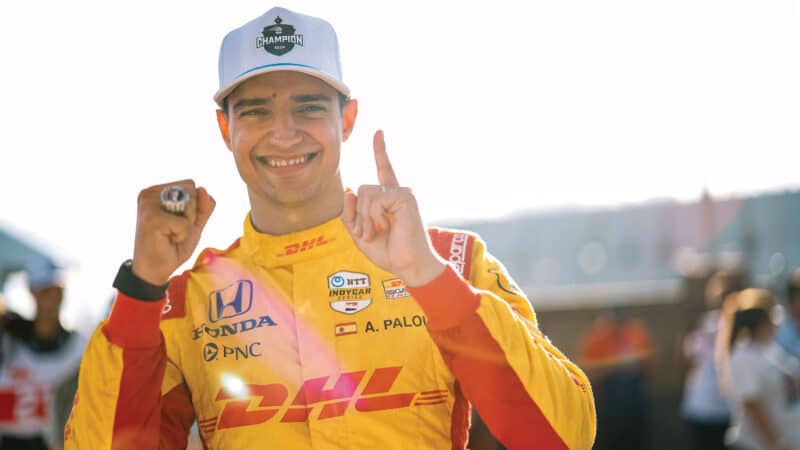
With three IndyCar titles in four seasons, Spaniard Palou is another rare talent to have raced for a Ganassi team
Joe Skibinski
Ganassi owned two franchises during IndyCar’s CART era, he was a team owner during the establishment of NASCAR’s charter system in 2016, and he went through the process yet again as the current iteration of IndyCar implemented charters late in the 2024 season. He controls the maximum of three, and he is convinced it was the right plan of action by Penske Entertainment to help IndyCar team owners establish and maintain value in their businesses.
“It’s going to take a little time for them to catch up to where NASCAR is, like it’s going to take NASCAR time to catch up to what the NFL does,” observes Ganassi. “First you need to get a charter/franchise system, and then you can talk about making the system better. I think that’s what all sports leagues are doing. But the first thing you’ve got to do is have one. IndyCar completed that step, and now we can all – the owners and the fans – begin to reap the benefit of that.”
Ganassi sometimes points out that unlike the motor sport magnates he is most often compared to – Penske and NASCAR top dog Rick Hendrick – racing is his primary and only business. He treats it 100% like a business, but it’s his passion for the sport – and, of course, winning – that keeps him coming back year after year.
“It’s what I do,” Ganassi reflects. “I like the team aspect. I like a lot of the people I run into, and I like all the things that go along with having a professional sports team. It’s certainly had its ups and downs. Thank God there’s more ups than downs, because that’s what makes it fun.
“The nice thing about this business is that you come back each year and you have to re-do it. Nobody cares about last year – it’s forgotten. You’re onto a new season and a new set of challenges, and there’s a level of excitement that goes along with that.”